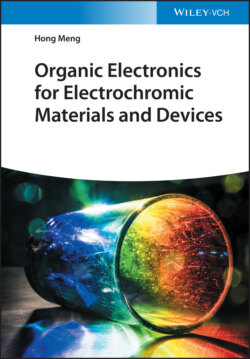Читать книгу Organic Electronics for Electrochromic Materials and Devices - Hong Meng - Страница 18
1.3.5 Stability
ОглавлениеIn most cases of laboratory study, researchers record the number of redox cycles that an EC material stand without significant loss in the performance as the electrochemical stability, irreversible oxidation or reduction at extreme potentials, side reactions with water or oxygen, and heat release in the system during switches may cause the degradation of electrochemical stability. Usually, the charge density Qd recorded under electrochemical cycling is up to 104–106, as shown in Figure 1.10a. The charge density of a Ti‐doped V2O5 EC film haven't changed through 2 × 106 cycles; meanwhile the transmittance change at a certain wavelength during continuous cycling is also important to describe the stability of an EC material. Such as shown in Figure 1.10b, the transmittance of the ECD remains stable through 200 000 cycles. Actually, the CE change after numerous cycles also can be used to evaluate the long‐term stability of EC materials, because it contains information of both transmittance and charge density.
Figure 1.10 Charge density (a) and transmittance (b) variation curves of ECD with the cycle number K : 1000.
Source: Wei et al. [30].
However, if we consider the real application of ECD in building windows, there are more strict conditions for durability and reliability. For instance, a lifetime over 20 years with more than 106 switching cycles is necessary. Extreme weather conditions such as temperatures below −20 °C and above +40 °C are huge challenge for both EC materials and electrolytes, as well as other degradation factors such as high solar irradiation levels, fast temperature changes, uneven temperature distribution and additional stresses, rain, humidity, mechanical shock, and drying. Therefore, in 1998, Carl M. Lampert proposed a standard test guideline for industry application of EC [31], as shown in Figure 1.11. Recently, the International Organization for Standardization (ISO) also has launched an international standard: Glass in building – Electrochromic glazings – accelerated aging test and requirements (ISO 18543) for EC use in buildings.
Figure 1.11 Recommended testing guidelines for EC windows for exterior architectural applications.
Source: Lampert et al. [31].
